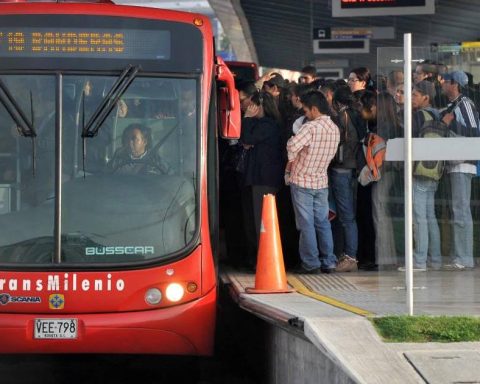In the coming weeks, the roadmap that the National Government will follow will be known to face the slowdown that has been going on for several months. It has important sectors such as industry and commerce in the red and has been characterized by a constant drop in investment. ; although it must be recognized that The economic dynamics have resisted more than expected in the projections.
This task was left in the hands of the Administrative Department of the Presidency. (Dapre), an entity that recently said that the plan was launched at the end of July and that the final compilation of strategies will be presented in October, since they are currently articulating the more than 150 proposals that they collected in their conversations with regional authorities , academia and guilds.
More information: Costs and bureaucracy, two barriers that keep labor informality stagnant
Meanwhile, opinions on which paths to take continue to arrive. On this occasion it was the turn of the Universidad de los Andes, which put on the table three paths that should be included in the reactivation project; taking into account that although Colombia’s economy recovered its pre-pandemic trend in 2021, since the fourth quarter of 2022 it has been negative and without signs of improvement.
GDP and investment
Before mentioning their proposals, the researchers from the Center for Studies on Economic Development (Cede) pointed out that the slowdown that the economy is experiencing must be reviewed from the disparity of the components of the Gross Domestic Product and the gap shown by investment from the private and public sectors and that they are marking the lines that require special attention.
Asobancaria says that one of the needs that the country has is the promotion of the capital market.
Private file
“As of 2021, household consumption remains above its long-term trend and government spending close to its trend. Another is the investment outlook, which throughout that period has been below trend and has widened that negative gap since 2022. That is, the deterioration of investment explains why increased household spending has not materialized in a decidedly positive GDP growth,” they indicated in the study.
In this sense, they indicate that investment has been lagging since 2015, when the fall in commodity prices marked the end of an economic boom and since then, the gap has deepened in 2023 and 2024, particularly in buildings, structures, and housing, while investment in machinery and equipment shows a smaller drop. Due to this, they conclude that mining and construction are the most affected sectors.
Also read: Fiscal rule: point of contention with the financing law
“Among the sectors that could counteract these brakes due to their importance in GDP, only public administration (15.5% of GDP) is above the trend, around 5.6 percentage points. Other sectors with positive behavior compared to their pre-pandemic trend are agriculture and the art and entertainment sector, highlighting the almost 60 percentage points above the trend in this last sector: this data, now on the supply side, is the other side of the increase in recreation and cultural expenses highlighted previously,” they noted.
With all of the above, they warned that “the relatively low weight of both in GDP (6.2% from agriculture and 3.2% from arts and entertainment) considerably limit the aggregate growth that can be leveraged in these sectors.”
three paths
After analyzing what is happening with the economic dynamics, Cede proposes three paths to overcome the downturn, starting by promoting investment to promote strategic sectors such as construction and civil works, which from its perspective have shown a significant gap compared to the trend of years ago and could be overcome with an intelligent alliance between the Government and the private sector.

Economic growth
iStock
“An adequate reactivation of the construction sector could have other effectss positive, such as reducing the housing deficit and, with this, multidimensional poverty and would lay the foundations for sustained economic growth in the future; laying the foundations to gain competitiveness in the regional market and become an attractive destination for investment,” the academics highlighted.
Another important avenue that the country must review is the reactivation of key sectors such as mining, industry, and commerce, which for the Universidad de los Andes present a notable drop in their performance and have a considerable weight in the GDP, therefore that its recovery is essential to reverse the economic slowdown.
The researchers also highlighted the need to diversify the Colombian economy beyond the primary sector, a point at which they recalled that the country has depended on commodities to throughout history and this has left it vulnerable to fluctuations in international prices.
Other news: Another 4G concession would be at risk of being liquidated: what will happen to the works?
“The first factor behind the current depression of investment with respect to its trend is historical and related to the fall in commodity prices after the aforementioned boom. It seems, then, to reflect the inability of the economy to take advantage of that boom to build sources of growth and investment outside the primary sector,” they explained, while maintaining that because of this it is necessary to develop new sources of growth.
On the alternatives that could be attractive in the face of sustained growthraised options such as the technological sectors, renewable energies and modern services could increase the resilience of the economy in the face of external crises and guarantee more stable growth.

Colombian pesos
iStock
Finally, they took a look at the financing law and stated that its proposals do not clearly show that they contribute to economic reactivation, and in particular for the priority need to reactivate by boosting investment.
“In fact, they could have the opposite effect, especially if fiscal sustainability or credibility are undermined. Of course, greater space for public spending that would be provided by approval of the current financing law. It can also help in itself to boost the economy from public demand,” they concluded.
















